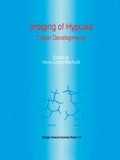Abstract
[18F]Fluoromisonidazole (FMISO) and PET have been used successfully to visualize hypoxia in tumors (Rasey 1989, Koh 1992) and other tissues (Shelton 1989, Martin 1993) as discussed in further details in chapter 6. Due to the physiological metabolism of FMISO in the liver, no attempts have been made so far to evaluate FMISO in detecting liver hypoxia since nitroimidazole and derivatives are known to undergo considerable hepatic metabolism. Under aerobic conditions, FMISO is metabolized by the isolated perfused liver predominantly into a β-glucuronide and three minor unidentified metabolites, whereas under hypoxic perfusion conditions, the β-glucuronide is a minor metabolite (Smith 1983). Due to this hepatic metabolism including biliary excretion, it has been questioned whether FMISO would be a suitable tracer for liver hypoxia imaging. Detection and quantification of liver hypoxia, however, would highly improve our knowledge
-
in the treatment of chronic liver diseases,
-
in the follow-up and treatment of primary and metastatic liver tumors and,
-
most importantly, in the diagnostic evaluation and treatment of liver transplant disorders.
Access this chapter
Tax calculation will be finalised at checkout
Purchases are for personal use only
Preview
Unable to display preview. Download preview PDF.
References
Anaise D., Oster Z.H., Atkins H.L., Arnold A.N., Weis S., Waltzer W.C., Rapaport F.T. Cortex perfusion index: a sensitive detector of acute rejection crisis in transplanted kidneys. J Nucl Med 27 (11): 1697–70 (1986).
Bennett W. Basic mechanisms and pathophysiology of cyclosporine nephrotoxicity. Transplant Proc 17: 297–302 (1985).
Gadano A, Durand F, Degott C, Dosguet C, Moreau R, Hadengue A, Widmann JJ, Vach-iery F, Elman A, Sogni P, Yang S, Valla D, Bernuau J, Belghiti J, Erlinger S, Lebrec D. Studies of portal hemodynamics and hepatic oxygen consumption during acute liver allograft rejection. Transplantation 27: 1188–1192 (1997).
Greenway CV. Role of splanchnic venous system in overall cardiovascular homeostasis. Federation Proc 42: 1678–1684 (1983).
Gelman S, Fowler KC, Smith LR. Liver circulation and function during isoflurane and halothane anesthesia. Anesthesiology 61: 726–730 (1984).
Hotchkiss R.S., Rust R.S., Dence C.S., Wasserman T.H., Song S.K., Hwang D.R., Karl I.E., Welch M.J. Evaluation of the role of cellular hypoxia in sepsis by the hypoxic marker [18F]fluoromisonidazole. Am J Physiol 261 (4 Pt 2): R965–72 (1991).
Koh W.-J., J.S. Rasey, M.L. Evans, J.R. Grierson, T.K. Lewellen, M.M. Graham, K.A. Krohn, T.W. Griffin. Imaging of hypoxia in human tumors with [F-18]Fluoromisonidazole. Int. J. Radiation Oncology Phys 22: 199–212 (1992).
Kurokawa T, Nonami T, Ujita T, Harada A, Nakao A, Takagi H. Dopamine compensates for deterioration of hepatic hemodynamics and metabolism during occlusion and reperfusion of the hepatic artery. Arch Surg 130: 1085–1089 (1995).
Lemmi C.A.E., Pelikan P.C.D., Sikka S.C., Hirschberg R., Geesaman B., Miller R.L., Park K.S., Liu S-C., Rajfer J. Cyclosporine augments renal mitochondrial function in vivo and reduces renal blood flow. Am J Physiol 257: F837 - F841 (1998).
Leszczynski D., Laszczynska M., Malttunen J., Hayry P. Renal target structures in acute allograft rejection: a histochemical study. Kidney Int 31: 1311 (1987).
Martin G.V., J.E. Biskupiak, J.H. Caldwell, J.S. Rasey, K.A. Krohn. Characterization of iodovinylmisonidazole as a marker for myocardial hypoxia. J Nucl Med 34: 918–924 (1993).
Matsumoto Y., McCaughan G.W., Painter D.M., Bishop G.A. Evidence that portal tract microvascular destruction precedes bile duct loss in human liver allograft rejection. Transplantation 56 (1): 69–75 (1993).
Omland E, Mathisen O. Hepatic and splanchnic metabolism of plasma proteolytic enzymes before, during, and after clamping of the hepatic artery and portal vein. Transplantation 52: 972–979 (1991).
Pardo-Mindan F.J., Salinas-Madrigal L., Idoate M., Garola R., Sola I., French M.: Pathology of renal transplantation. Seminars in Diagnostic Pathology 9 (3): 185–199 (1992).
Rasey J.S., Koh Wui-Jin Koh, J.R. Grierson, Z. Grunbaum, K.A. Krohn. Radiolabeled fluoromisonidazole as an imaging agent for tumor hypoxia. Int J Radiation Onclology Biol Phys 17: 985–991 (1989).
Shelton M.E., C.S. Dence, D.-R. Hwang, M.J. Welch, S.R. Bergmann. Myocardial kinetics of Fluorine-18 Misonidazole: a marker of hypoxic myocardium. J Nucl Med 30: 351–358 (1989).
Smith B.R., Born J.L., Garcia D.J.: Influence of hypoxia on the metabolism and excretion of misonidazole by the isolated perfused rat liver–a model system. Biochem Pharmacol 32: 1609–1612 (1983).
Sweeney G.D. Functional heterogeneity among liver cells: implications for drug toxicity and metabolism. In: Lamble J.W., ed. Drug metabolism and distribution. Current reviews in biomedicine 3. Amsterdam: Elsevier Medical Press, 42–48 (1983).
Takemura M., Oguma S., Mori S., Ishii M., Starzl TE., Demetris AJ., Takahasi T. Peribiliary vascular diseases in rejected livers; computer-aided three-dimensional reconstruction and morphometry. Transplant Proc 23 (1 Pt 2): 1409–12 (1991).
Viebahn R., Metzdorf B., deGroot H., Lauchart W. Simulation of hypoxic and preservation injury in human hepatocyte cultures: Influence of FK 506 and cyclosporine. Transplant Proc 25 (4): 2691–2692 (1993).
Editor information
Editors and Affiliations
Rights and permissions
Copyright information
© 1999 Springer Science+Business Media Dordrecht
About this chapter
Cite this chapter
Piert, M., Machulla, HJ. (1999). Detection of Liver Hypoxia by [18F]Fluoromisonidazole and Application in Liver Transplant Disorders. In: Machulla, HJ. (eds) Imaging of Hypoxia. Developments in Nuclear Medicine, vol 33. Springer, Dordrecht. https://doi.org/10.1007/978-94-017-1828-8_7
Download citation
DOI: https://doi.org/10.1007/978-94-017-1828-8_7
Publisher Name: Springer, Dordrecht
Print ISBN: 978-90-481-5157-8
Online ISBN: 978-94-017-1828-8
eBook Packages: Springer Book Archive

